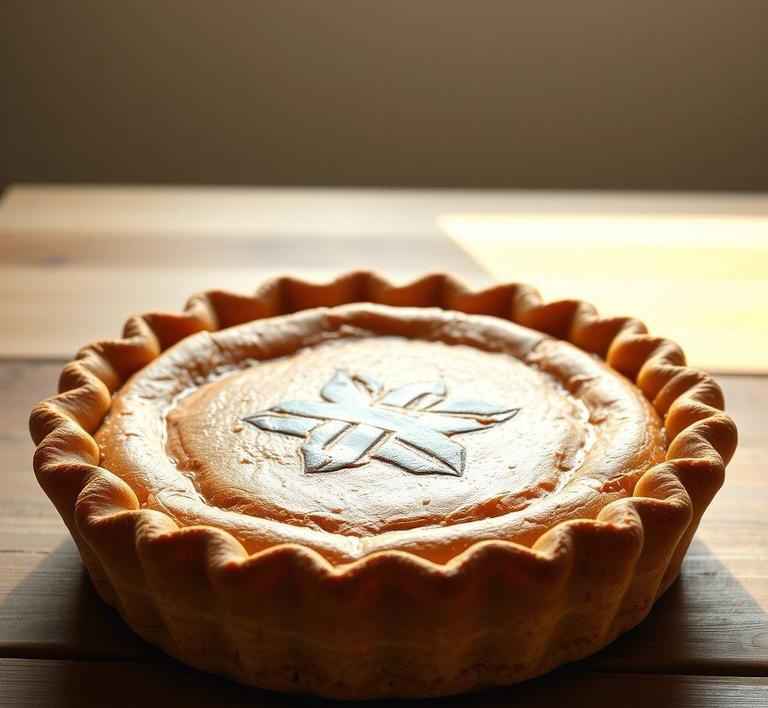So, you’ve got a leftover pumpkin pie and you’re wondering if you can refreeze it for later? Great news – you totally can! Refreezing pumpkin pie is a fantastic way to save that delicious dessert for another time without losing its flavor or texture. Whether you baked it yourself or got a store-bought pie that you couldn’t finish, this guide will walk you through how to do it safely and without compromising that perfect, creamy filling. Let’s dive in and make sure your pumpkin pie is just as tasty the second time around!
Can You Refreeze Pumpkin Pie?

When it comes to pumpkin pie, a holiday favorite that is both rich in flavor and tradition, the question of whether or not you can refreeze it can be a bit perplexing. The good news is that yes, you can refreeze pumpkin pie-but the details are important.
Initially, freezing pumpkin pie is an excellent method for preserving this delicious dessert, especially if you want to prepare ahead of time. However, the situation becomes a bit trickier when you want to refreeze a pumpkin pie that has already been thawed or partially eaten. The act of refreezing is not as straightforward as freezing for the first time, because the process involves some key factors that can affect both the texture and taste of the pie. Understanding these elements is crucial if you want to preserve the pie’s integrity and flavor.
So, while you technically can refreeze pumpkin pie, it’s important to recognize that repeated freezing and thawing can compromise the quality of the dessert. The texture, the filling consistency, and even the crust might not hold up well after being frozen, thawed, and refrozen. The ingredients in pumpkin pie, particularly the custard-like filling, can separate and become watery, and the flaky crust might lose its crunch.
How To Refreeze Pumpkin Pie?
If you find yourself in a situation where you must refreeze a pumpkin pie, the process isn’t as simple as just tossing it back into the freezer. To ensure that you’re giving your pie the best possible chance at holding up to a second freeze, here’s a step-by-step guide on how to refreeze it:
-
Cool the Pie Completely
Before even considering refreezing, ensure that your pumpkin pie is completely cool. If the pie is still warm, freezing it could cause condensation inside the wrapping, which leads to the formation of ice crystals. These ice crystals are one of the culprits that affect texture when thawed.
-
Wrap it Properly
After the pie has cooled, wrap it tightly in plastic wrap to prevent air from getting in, as exposure to air leads to freezer burn. Next, wrap the plastic-covered pie in aluminum foil or place it in a freezer-safe plastic bag. If you’re using a bag, try to remove as much air as possible to reduce the risk of freezer burn. The more tightly it is wrapped, the better preserved the pie will be.
-
Label and Date It
You don’t want to lose track of how long your pie has been in the freezer, especially since the quality of the pie will degrade the longer it stays frozen. Write the date of freezing on a label, so you can monitor how long it’s been since the refreeze. Ideally, you should refreeze pumpkin pie within 1-2 days of thawing.
-
Freeze it Again
Once wrapped, place the pie in the freezer. Try to keep it in an area of the freezer where it won’t be jostled or moved around, as any disturbance can cause cracks or leaks in the filling.
-
Thawing the Pie
When you’re ready to eat the refrozen pie, make sure to thaw it properly. The best method is to place the pie in the fridge for several hours or overnight to slowly return it to a usable state. Avoid defrosting at room temperature, as this can lead to further condensation and an unpleasant sogginess in the crust.
Quality Impact
While refreezing pumpkin pie is technically possible, the impact on quality can be significant. The major issue that arises is the texture of both the filling and the crust. Let’s break down how each component is affected:
1. The Filling
The filling of a pumpkin pie is made from a mixture of eggs, cream, sugar, and pureed pumpkin, which together form a custard-like texture when baked. This custard filling is prone to separation after being frozen and thawed. The freezing process causes the liquid in the pie to form ice crystals. When the pie is thawed, these crystals melt and can make the filling watery and grainy, resulting in a less-than-ideal texture. Additionally, the rich flavor of the pumpkin filling may become diluted after the refreezing process.
Another issue is that the spices in the pie, such as cinnamon, nutmeg, and ginger, may lose some of their potency after multiple rounds of freezing and thawing. This can make the pie taste slightly duller, even if the initial spice blend was vibrant.
2. The Crust
The crust of a pumpkin pie is typically flaky, and it provides a delicate contrast to the smooth filling. Unfortunately, this texture is particularly susceptible to deterioration when frozen and refrozen. The crust can become soggy or overly soft after thawing because of moisture trapped inside the pie. If the pie wasn’t wrapped tightly enough, freezer burn can also cause the crust to harden, losing its characteristic flakiness and becoming more brittle.
In many cases, the refrozen pie may also experience shrinkage of the crust, especially around the edges. This is because of the expansion and contraction of the dough during the freezing and thawing process.
3. Overall Flavor And Aroma
Freezing and refreezing can cause the pie’s flavor to degrade slightly. The subtle aromas of cinnamon, clove, and nutmeg may fade, and the pie could lose some of the depth of flavor. This happens because freezer storage can lead to oxidation, which dulls flavors over time.
In conclusion, while refreezing pumpkin pie is safe and won’t cause harm, it does come at the cost of a noticeable drop in quality. The texture of both the crust and the filling can suffer, and the flavors may become less vibrant, so it’s not ideal if you’re trying to serve it at its best.
So, can you refreeze pumpkin pie? Yes, but with caution. The reality is that while it’s possible, the process can severely affect the quality of your pie, particularly in terms of texture and flavor. The flaky crust and creamy filling may lose their appeal after being frozen and thawed multiple times.
If you need to refreeze your pumpkin pie, follow the proper steps for wrapping and storage to minimize quality loss. However, it’s important to keep expectations realistic. If you want to experience pumpkin pie at its freshest and most flavorful, it’s always best to freeze it just once-either before or after baking-and consume it soon after thawing. Refreezing should be reserved for situations where it’s unavoidable, and even then, the pie may not be quite as decadent as when it was freshly made.
Is It Safe To Refreeze Pumpkin Pie?
Refreezing pumpkin pie may seem like a convenient option for preserving leftovers, but it’s important to understand the potential consequences before you make that decision. When it comes to pies with a creamy filling like pumpkin pie, the refreezing process can be a bit tricky.
In general, the safety of refreezing any food depends on how it has been handled. If you’ve thawed the pie at room temperature or in the refrigerator, and it has not been sitting out for too long, it can be refrozen, but the texture and taste may suffer significantly.
When you refreeze pumpkin pie, the moisture in the filling, along with the butter and eggs, can cause the pie to lose its original creamy consistency. The crust might also become soggy and unappetizing due to excess moisture. If the pie was left out at room temperature for an extended period (more than 2 hours), it may not be safe to refreeze because bacteria can grow rapidly at those temperatures. As with any perishable food, the rule of thumb is: if in doubt, don’t refreeze.
Safety Tips
- Thawing properly: Always thaw the pie in the refrigerator, not on the counter, to minimize the risk of bacterial growth.
- Refreezing only once: Ideally, you should never refreeze anything that has already been frozen once. The quality degradation increases with each freezing cycle, but more importantly, there’s a risk of foodborne illness.
Signs That Pumpkin Pie Should Not Be Refrozen
There are certain telltale signs that your pumpkin pie should not be refrozen, either due to safety concerns or the fact that it has reached a point where the refreezing process will ruin its quality.
- Separation in the Filling: If the filling of the pumpkin pie has started to separate after being thawed, this is a sign that the custard base (which contains eggs and milk) has broken down. Refreezing a pie with this texture will lead to an unpleasant, curdled filling once it’s thawed again.
- Soggy or Wet Crust: If the pie’s crust has absorbed too much moisture during the thawing process, it will become soggy and limp, which will only worsen after refreezing. A soggy crust is a good indicator that the pie should not be refrozen.
- Discoloration: Any discoloration on the pie, especially the filling, is a sign that it’s been exposed to air or that it has been sitting out too long. The color may change from a rich orange to a dull, off shade. Once this happens, bacteria may have started to grow, and it’s not safe to refreeze.
- Off Smell: If the pie develops an unusual or sour odor, this is a clear sign of spoilage. Smell is one of the quickest ways to tell if a pie should be discarded or not.
Common Refreezing Mistakes
While refreezing pumpkin pie may seem straightforward, people often make a few common mistakes that can lead to unpleasant results or even health risks. Here are some things to avoid:
- Refreezing After Long Thawing Times: One of the biggest mistakes people make is letting their pumpkin pie thaw at room temperature for too long. If the pie has been sitting out for more than 2 hours, the outer layers might have warmed up enough for bacteria to thrive. Thawing should always happen in the refrigerator to ensure the pie remains at a safe temperature.
- Not Wrapping Properly: If you plan to refreeze pumpkin pie, make sure it is wrapped tightly in plastic wrap or aluminum foil before storing it in an airtight container or freezer bag. Failing to do so can cause freezer burn, which will lead to a loss of texture and flavor when the pie is thawed again.
- Refreezing Multiple Times: As mentioned earlier, it’s important to avoid refreezing pumpkin pie more than once. Each time it is thawed and refrozen, its texture degrades further, and the chances of bacterial contamination increase.
- Ignoring Storage Time: If your pie has already been in the freezer for months, it might not be safe or flavorful to refreeze. The optimal time for refreezing a pumpkin pie is within a couple of weeks of its initial freeze. After a long time in the freezer, the pie may have suffered from freezer burn or loss of flavor.
Tips And Tricks For Refreezing Pumpkin Pie
Refreezing pumpkin pie successfully requires careful planning and attention to detail. Here are some tips to ensure you get the best results:
- Cool the Pie Completely Before Freezing: Always allow the pumpkin pie to cool completely before freezing it. If it’s still warm, moisture will form inside the wrapping, leading to ice crystals and a soggy crust.
- Use a Foil Pie Pan: If you plan to refreeze the pie, consider using a disposable foil pie pan. This way, you can easily wrap it and store it without worrying about damaging your regular pie pan. Plus, foil pans freeze more evenly.
- Label the Pie: It’s a good practice to label your frozen pies with the date they were made and the date they were frozen. This way, you’ll know exactly how long they’ve been in the freezer and when they need to be used by.
- Consider Freezing Individual Slices: Instead of freezing an entire pie, slice it into individual pieces. This makes it easier to refreeze only what you’ll need and reduces the risk of repeatedly thawing and refreezing the entire pie.
- Thaw Slowly in the Refrigerator: When you’re ready to enjoy your refrozen pie, thaw it in the refrigerator overnight instead of at room temperature. This will help maintain the texture and reduce the risk of bacterial growth.
- Reheat to Refresh the Crust: If the crust becomes soggy after freezing and thawing, you can refresh it by reheating the pie in the oven at a low temperature (about 325°F) for 10 to 15 minutes. This will help crisp it up again.
Conclusion
Refreezing pumpkin pie can be safe, but it comes with some risks that can compromise the quality of your dessert. While it’s safe to freeze a pumpkin pie initially, refreezing it after thawing should be done with caution. Always check for signs like separation in the filling, soggy crust, or strange odors before deciding to refreeze. If the pie is still in good shape and hasn’t been sitting out for too long, you can refreeze it, but it’s important to handle it properly to avoid ruining the texture or, worse, creating food safety issues.
By following the tips and tricks mentioned, you can enjoy your leftover pumpkin pie without fear of spoilage or loss of flavor. However, remember that the best way to enjoy pumpkin pie is to eat it fresh – once it’s frozen and refrozen, its quality will inevitably decline. When in doubt, it’s always better to share your leftovers with family or friends rather than risk ruining them by refreezing!


